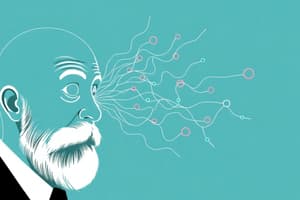Podcast
Questions and Answers
What was the purpose of the Stanford prison experiment?
What was the purpose of the Stanford prison experiment?
- To examine the effects of situational variables on participants' reactions and behaviors (correct)
- To study the impact of prison life on psychological stability
- To investigate the effectiveness of de-individuation in a prison environment
- To analyze the behavior of real prison guards
How were the participants recruited for the Stanford prison experiment?
How were the participants recruited for the Stanford prison experiment?
- Through a newspaper ad offering $15 per day to male students (correct)
- Via direct invitation to Stanford University psychology students
- Through an online survey on attitudes towards authority
- By contacting individuals with a background in law enforcement
How were the 'guards' in the Stanford prison experiment instructed to behave?
How were the 'guards' in the Stanford prison experiment instructed to behave?
- To establish friendships with the 'prisoners'
- To prevent prisoners from escaping (correct)
- To avoid any interaction with the 'prisoners'
- To provide counseling to the 'prisoners'
When did the Stanford prison experiment officially start?
When did the Stanford prison experiment officially start?
What has been a point of criticism regarding the Stanford prison experiment?
What has been a point of criticism regarding the Stanford prison experiment?
According to Freud's Psychoanalytic Theory, which of the following is a personality structure?
According to Freud's Psychoanalytic Theory, which of the following is a personality structure?
During which stage of personality development does the Oedipus Complex occur?
During which stage of personality development does the Oedipus Complex occur?
Which of the following is a critique of the Psychoanalytic Perspective based on modern research?
Which of the following is a critique of the Psychoanalytic Perspective based on modern research?
According to modern research, which statement about dreams is supported?
According to modern research, which statement about dreams is supported?
Which of the following is a defense mechanism identified by Freud's Psychoanalytic Theory?
Which of the following is a defense mechanism identified by Freud's Psychoanalytic Theory?
Who led the Stanford prison experiment?
Who led the Stanford prison experiment?
What was the main focus of the Stanford prison experiment?
What was the main focus of the Stanford prison experiment?
How were the 'guards' in the Stanford prison experiment instructed to behave?
How were the 'guards' in the Stanford prison experiment instructed to behave?
How were volunteers chosen to participate in the Stanford prison experiment?
How were volunteers chosen to participate in the Stanford prison experiment?
When did the Stanford prison experiment officially start?
When did the Stanford prison experiment officially start?
Flashcards are hidden until you start studying
Study Notes
Stanford Prison Experiment
-
The Stanford Prison Experiment was a psychological study that aimed to examine the psychological effects of power, authority, and roles on individuals.
-
Participants were recruited through newspaper advertisements and were paid $15 per day for their participation.
-
The 'guards' were instructed to maintain order and control within the simulated prison environment, but they were not given any specific instructions on how to behave.
-
The Stanford Prison Experiment officially began on August 14, 1971.
-
A major point of criticism regarding the Stanford Prison Experiment is the ethical concerns related to the study's methodology and the potential harm inflicted on the participants.
Psychoanalytic Theory
-
Id, Ego, and Superego are the three personality structures according to Freud's Psychoanalytic Theory.
-
The Oedipus Complex occurs during the phallic stage of personality development, which is typically between ages 3 and 6.
-
A critique of the Psychoanalytic Perspective is that many of its key concepts are difficult to test and measure scientifically.
-
Modern research suggests that dreams are not necessarily symbolic representations of unconscious desires but rather reflect everyday thoughts and experiences.
-
A defense mechanism identified by Freud's Psychoanalytic Theory is repression.
Stanford Prison Experiment: Key Details
-
Philip Zimbardo led the Stanford prison experiment.
-
The main focus of the Stanford prison experiment was to study the psychological effects of power, authority, and roles on individuals in a simulated prison environment.
-
The 'guards' were instructed to maintain order and control within the simulated prison environment, but they were not given any specific instructions on how to behave.
-
Volunteers were chosen for the Stanford Prison Experiment based on a screening process that included psychological evaluations to ensure they were mentally and physically healthy.
-
The Stanford Prison Experiment officially began on August 14, 1971.
Studying That Suits You
Use AI to generate personalized quizzes and flashcards to suit your learning preferences.




